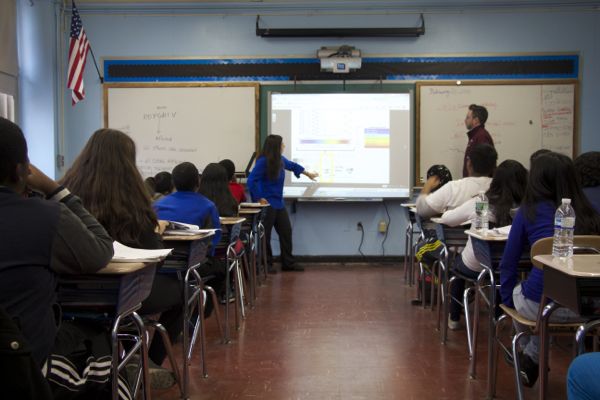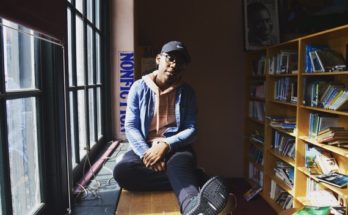
Luisa Cavagna’s first day teaching at Brooklyn’s Ditmas Junior High School also happened to be the first time she had ever set foot in a public school. When she arrived at the large and diverse school in Flatbush, with just a few months of New York City Teaching Fellow summer training under her belt, the 22-year-old from Throgs Neck found herself in classrooms wildly different from the ones she knew as a student at Sacred Heart Private School in the Bronx and Loyola School on the Upper East Side.
Class sizes were bigger. Students were rowdier. Many kids were in the habit of not doing their homework, something she couldn’t quite believe at first. And when she stepped inside a classroom for the first time armed with an ambitious five-page syllabus, the teacher leaving the room took one look at Cavagna’s papers and said, “You know they don’t speak very much English, right?”
That was two years ago. Cavagna, now 24, is still teaching science at Ditmas – only now, she knows how much material she can get through in 45 minutes, how to take control of a classroom, and how to tailor her lessons to students of all abilities. Described by the school’s principal as popular with students and by colleagues as highly energetic, Cavagna is the type of person the New York City Teaching Fellows program hopes to attract and retain: hardworking, quick-thinking, and always striving to be better.
For the past 14 years, NYC Teaching Fellows has trained over 16,000 new teachers and placed many of them in urban, lower-income neighborhoods in Brooklyn and the Bronx. Fellows receive a summer of intensive training, and then work towards earning their masters degrees (which are highly subsidized: the Department of Education pays all but $7,500 per student) during their first two years of full-time teaching. Though the program prides itself on having brought more qualified teachers to the schools that need them most; critics argue that most Fellows arrive in classrooms with less experience than graduates of traditional education school programs.
Cavagna became a Teaching Fellow immediately after graduating from New York University three years ago. She had grown up determined to become doctor, but turned to teaching after volunteering in a hospital made her realize that medicine wasn’t for her. Having found some fulfillment in tutoring, she applied to the Teaching Fellows program and got in (no small feat, considering only 9 percent of applicants were admitted in June of 2011).
According to NYC Teaching Fellows’ data, 92 percent of Fellows complete their first year of teaching. But the rate of those who stay in the system soon drops. Eighty-seven percent begin a second year of teaching, 74 percent a third. Five years down the line, about half remain. Teacher retention isn’t a problem exclusive to the program – Teaching Fellow retention rates are on par with, or in some cases, surpass the city and national averages – but it’s worth noting, considering it costs thousands of dollars to train Fellows each year.
Cavagna admitted that many of the teachers she started with have since left teaching. She also suspects that some Fellows who enter the program are more interested in adding a prestigious line to their resumes than committing to becoming teachers. Then there are those who are earnest and enthusiastic during training but find themselves completely overwhelmed in the classroom.
She thinks one of the most common reasons people drop out is a lack of preparation. “It’s nothing like you envision until you actually try it out,” she said.
A crash course on teaching essentials, such as establishing rules and managing a classroom, put her at ease, but the practical component of conducting a summer school lesson didn’t exactly mimic the dynamic of a typical day at Ditmas. The kids in her summer school class – all six of them – were very well behaved. And there was also another teacher in the room as she taught.
As she expected, her first year teaching full-time was the roughest. She struggled dealing with so many kids at once (the average science class size at Ditmas, according to the Department of Education, is 27) and getting through her lesson plans. Her self-described Type A personality seemed to set her up to fail. She had ambitious plans for what could be covered during each class, but had to stop so many times to check homework – “if you don’t check it, they don’t do it!” – that she found herself rushing to cover material in the allotted time.
She was also shocked by the kids’ behavior, which was so unlike that of the students she’d grown up with. Normally a quiet person, she found herself raising her voice often, before eventually discovering a more effective way of getting her students’ attention. “Just stopping makes them really uncomfortable,” she said with a smile. “And if they’re uncomfortable, they’re more likely to tune into what’s going on because they think they’re missing something.”
By January of that first year, she was really questioning herself. But once accepting the fact that perfection isn’t always possible, she started making minor improvements to her teaching style and studying how her students reacted. Sure enough, soon came small but significant victories: a student who never did his homework started coming to school with the work done. Another who was always half-asleep made an amazing connection in class.
“It makes you realize there is a reason to it,” she said. “Without finding ways to acknowledge that, this job could be really overwhelming.”
During her first two years of teaching, she spent much of her class time explaining concepts and giving instruction herself. Now she’s more comfortable supervising group work and planning lessons that are more varied and dynamic. And she has a much better sense of control over what goes on in the classroom.
At 4-foot-11, she barely stands taller than some of her seventh grade students. But they know who’s in charge. Entering her third period Gifted and Talented class for the first time since winter break, students smile at her and one calls out, “We missed you!”
“Because I have not seen you all since before the break, I’m going to check homework individually today,” she says in a voice that is firm without being strict.
“Oh shit!” one student blurts under his breath. The class is silent for the most part as she makes her way from group to group, making sure students understand the reading on light and refraction that they were given over the break. If the volume of chatter begins to creep above a certain threshold, she’s not afraid to tell the class to be quieter. Nor does she shy away from telling students they could have done a better job on their assignments.
“What’s my initial comment going to be?” she asks one boy as she flips through his booklet of readings.
“It’s not marked up,” the boy says, his eyes down.
“It’s not marked up,” she confirms. New standards called the Common Core emphasize close reading and annotating, or what educators call “talking to the text.” Cavagna’s been trying to implement Reading Apprenticeship, a literacy framework (run by San Francisco nonprofit West Ed) based on student engagement with words, in all of her classes. She asks students to cite specific page numbers as evidence for their arguments and encourages them to search for only the most relevant parts of a text.
Part of what has kept Cavagna at Ditmas has been the relationships she’s been able to form with her colleagues – something she says a lot of Teaching Fellow drop-outs didn’t have. One of her mentors is Raven Roytblat, a veteran English language arts teacher who has answered her questions and helps talk her through any problems that come up in the classroom.
Roytblat recalled the first time she saw Cavagna in a classroom.
“She came in with her cart, which was bigger than she was, and she had all of her handouts,” Roytblat said, laughing at the memory. “She was wearing all of her grown up clothes but still looked as fresh faced as a kid.”
Roytblat could tell from the start that Cavagna was hardworking, but over time she has watched her learn from mistakes and grow into the confident, capable teacher she is now. She could tell a major transformation had occurred over a year ago when she took a peek inside the classroom and found that Cavagna was not in her usual post at the front of the room but was walking between clusters of students who were engaged in group discussions. The two women now often spend lunches together, thinking up ways they can collaborate on cross-disciplinary lesson plans.
Royblat, a graduate of the teachers college at St. John’s University, respects the Teaching Fellows program. But she would like to see Fellows get into classrooms as soon as possible and learn how to teach in different kinds of schools.
“Many years ago, many of the Fellows would be wonderful teachers in Oklahoma – but not successful in a middle school in Brooklyn,” she said.
“The sooner a program introduces their student to the environment in which they are most likely going to be teaching in, the more useful it will be.”
The Teaching Fellows program, often criticized for not providing fellows enough practical experience, has since introduced an optional 10-week training period during which Fellows spend more time teaching in classrooms.
“If I had gone into the spring apprenticeship, I would have had a better understanding of what I was up against,” Cavagna said.
One of her biggest challenges at Ditmas is dealing with students who come to class without their homework done. One of her students, for example, is absent a lot because his mother is sick and the family is in and out of a shelter. When he does come to school (usually about 10 days in any given month), he tries to do the work, but without having done homework, there are barriers to how well he can complete classwork and perform on tests.
Challenges aside, Cavagna isn’t thinking of leaving the school any time soon. Though her commute is long (she lives on Long Island with her fiancé, and it took her over six hours to get home during a snowstorm this winter) and she could apply to work somewhere else, she’s convinced the work she is doing is meaningful.
“Even though there is a potential for a higher salary and more prestige with going to a suburb,” she said, “and I’d obviously I’d be closer to home… There’s something about this – maybe I’m crazy – but I enjoy the people I work with. I enjoy that it’s always going to be different.”



